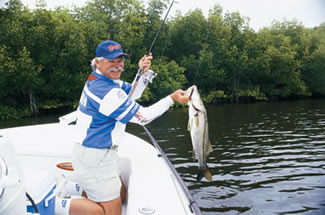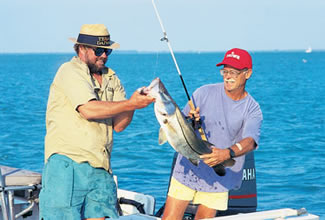February 01, 2005
By Chris Christian
The Myakka is a case study in classic blackwater snook fishing.
There is nothing like getting a quick start to the day, and this was about one of the quickest starts I could remember.

True to his name, Capt. Fred Winters finds success on early season snook on the upper Myakka River. |
We had launched near the El Jobean Bridge at the mouth of the Myakka River and motored a few hundred yards to the bridge pilings. The outgoing tide had about another hour to run, which is as good a tide stage as you can get for the bridge, and it wasn't more than a few casts before Capt. Fred Winters hooked our first snook. Moments later one inhaled my jig.
Short run, a few casts and snook on. I love it! So did the scattered pedestrians and anglers on the bridge. We had our own little audience and for the next hour we did our best to put on a show. We lost about as many as we hooked, as snook tend not to grab jigs with gusto when the water is a chilly 61 degrees. Still, a half-dozen found their way to the boat, and a couple were in the 30-inch-plus range.
The Myakka meanders across a considerable slice of Southwest Florida before it empties into Charlotte Harbor. The portion Winters considers the best is the lower section from its junction with the harbor extending up to Interstate 75. As the crow flies that's about 15 miles, although it's probably twice that far as the river winds.
The lower Myakka is broad, shallow and bisected by a few well-marked channels. If you're not intimately familiar with the area, pay close attention to those channel markers. There's a lot of rock and oyster here, and as you move upstream from the bridge, the bottom gets a little harder in spots.
“Idle zones also tend to discourage a lot of people from running up the Myakka,” Winters said. “But, it doesn't discourage the snook. What you get is an area that doesn't get a lot of fishing pressure, is kind of remote, and has some of the best winter and spring snook fishing around.”
Remote doesn't bother Winters. In fact, as a retired U.S. Army Green Beret with 27 years of service (who still has a remarkably good sense of humor) getting in and out of remote places is old hat.
A good oyster bar holds tarpon, snook and reds. |
|
“There are three good ramps along the river from the El Jobean Bridge to just about a mile south of I-75,” he notes. “They're spaced about five or six miles apart, and while the two upper river ramps are in the idle zone, if you pick the right one you can get into the section of the river you want to fish pretty quickly.”
The character of the river changes considerably over its short length.
The upper section is mostly fresh water, depending on the rainfall, and has holes on some outside bends that go down to 18 feet. It's narrow and the banks are lined with mangrove, cypress and blowdowns. Snook don't mind fresh water, and in the winter they are looking for the deepest, most stable water they can find.
“This is the best deepwater refuge in the river,” Winters explained. “It would be my first choice after we get our first major cold front in December, and it can be good all through January.”
Snook Haven fish camp has a pay-to-use ramp a mile or so west of I-75.
“It's aptly named,” noted Winters.
This is classic blackwater river angling. Winters starts his search on the deeper outside bends, where bigger snook start and end their feed. Look for where “wood meets water”—little eddies where snook bushwhack forage blundering along with the current. Short, accurate casts are the key, and Winters wants a bait that gets down quickly.
“A 4- or 5-inch soft-plastic jig is an excellent choice up here,” he said. “By changing the jighead weight you can control the depth it runs. I use anything from a 1/ 8- to a 3/ 8-ounce wide gap-hook jighead. The water is dark up there, so I like a dark body with a white or chartreuse tail.”
Hard-plastic sinking plugs are another good choice.

As the weather warms, snook move downriver to the open water of Charlotte Harbor. |
An afternoon outgoing tide is probably the best scenario for the upper river, Winters explained. “The sun tends to warm the north bank of the river, which can get the snook up tight to the shoreline. If you don't have that, they sometimes stay in the deeper holes on the bends, but a jig will reach them.”
As spring approaches, Winters moves down toward the rivermouth—since that is what a lot of the snook are doing—and his next key area is around the U.S. 41 bridge.
“The bridge is almost the dividing line between fresh and salt water,” he explained, “and here the river starts to open up a bit. You also start to see some side creeks, mangrove islands, and there is a good oyster bar at the bridge that holds tarpon, snook, reds and trout in the winter. Warm Mineral Springs Creek flows in just above the bridge, and that is 72-degree water. That area can hold fish all winter.”
Anglers often overlook the extensive system of manmade canals just downstream of the bridge. Dredged to varying depths, the deeper holes—or any large dock next to a hole—can hold snook, reds, trout and a bunch of 5- to 10-pound tarpon from January through February. Winters has had some very good guide days (including snook over 20 pounds) doing nothing more than probing those deeper canal holes and docks, with jigs, jerkbaits, and—on warm, overcast days—even topwater plugs.
While the area above the U.S. 41 bridge gets the nod in December and January, a warmup in February has Winters heading to the rivermouth. And, if he has the right tide, his first stop is invariably the El Jobean Bridge on State Road 776.
“This is a fish magnet once the water starts to warm towards spring,” he said. “You've got snook, big trout, reds, sheepshead, mangrove snapper, and you'll also get tarpon and cobia at times.”
The right tide is the last two hours of the ebb and the first two hours of the flood. Winters uses this lower current period to move the boat along the upcurrent side of the bridge and drop a 1/ 4-ounce jig tight to the pilings.
If Winters misses the “bridge tide” and has incoming water, that's not so bad. He just heads for the shallow maze of mangrove-lined bays around Hog Island, the Myakka Cutoff and Tippecanoe Bay. Most of these areas are shallow mud and oyster flats in one to three feet of water. When the weather warms in mid-February through April, they have a lot going for them.
“An incoming tide brings in baitfish, and warmer water from the Harbor,” Winters points out.
Combine rapidly warming water with an influx of baitfish and things start to happen. In fact, on my last trip with Capt. Winters, we exited the El Jobean Bridge with a 61-degree water temperature, and an hour later found 66 degrees in a shallow bay not more than a mile from the bridge. Thank you, incoming tide!
Snook were crashing our swimming jigs like jack crevalle on a midsummer feeding frenzy, and a few serious “slot reds” joined the party.
Outlook for Charlotte Harbor
The Myakka River feeds one of the fishiest bay systems in Florida: Charlotte Harbor. This famous body of water was ground zero for Cat-4 Charley during last year's wild hurricane season, but conditions were expected to clear up through winter, followed by steady recovery of seagrasses, mangroves and other fish-holding features.
With a spring warmup, snook holed up in the Myakka and nearby Peace rivers should become more active and move downriver toward open reaches of the harbor. Here, surface lures and darter-type plugs are ideal under low-light conditions. Night angling with noisy topwaters is productive for snook spring through summer around sandbars, submerged oyster reefs, mangrove points and cuts. High, running tides at dawn and dusk are excellent, and anglers can expect an occasional tarpon and redfish.
Seatrout action is a sure bet in spring. Heavy roe-laden females begin to show in March, and 5-pound-class fish are regularly released by anglers working live baits, grub jigs and plugs. Drifting patchy grassflats in three to six feet of water, while casting downwind with light spinning tackle, is a productive strategy. During cold snaps, trout school in deep channels, holes and around deepwater bridges.
April brings cobia to the mix, and the fish gravitate to channel markers, sandbars and roving stingrays and manatees. As mentioned in the main story, some even wander far up the Myakka River. By May, the Harbor should be packed to capacity with all manner of sportfish: Spanish mackerel, tarpon, sharks, tripletail and more.
FS

